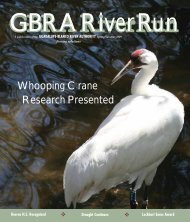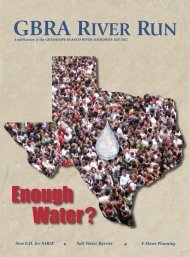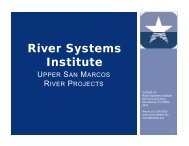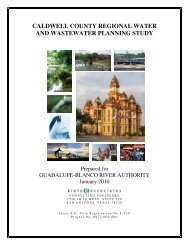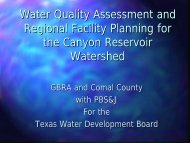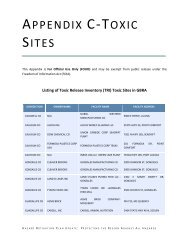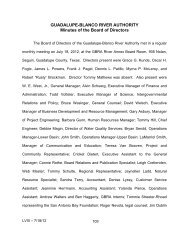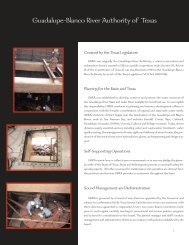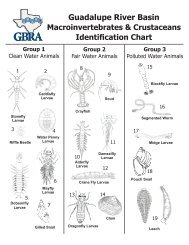A Water Solution for Texas - Guadalupe-Blanco River Authority
A Water Solution for Texas - Guadalupe-Blanco River Authority
A Water Solution for Texas - Guadalupe-Blanco River Authority
- No tags were found...
Create successful ePaper yourself
Turn your PDF publications into a flip-book with our unique Google optimized e-Paper software.
GBRA RIVER RUNA publication of the GUADALUPE-BLANCO RIVER AUTHORITY Summer 2012Seawater Desal:A <strong>Water</strong> <strong>Solution</strong> <strong>for</strong> <strong>Texas</strong>Publication Awards • <strong>Water</strong> Safari Photos• Gorge 10th Anniversary
From the GMBalance Needed in <strong>Water</strong> Flow ProtectionsThe environmental flows (or “e-flows”) process set up as part of Senate Bill 3 to determine instream flows and flows to <strong>Texas</strong>’bays and estuaries has a set of stakeholders <strong>for</strong> each regional planning area. The planning group in which the <strong>Guadalupe</strong>-<strong>Blanco</strong><strong>River</strong> <strong>Authority</strong> (GBRA) falls is comprised of 25 stakeholders. These stakeholders, with the exception of GBRA, the City of Victoriaand the City of New Braunfels, submitted e-flow recommendations to the <strong>Texas</strong> Commission <strong>for</strong> Environmental Quality (TCEQ) thatfailed to meet the SB-3 requirement of balance “in conjunction with other factors, including the present and future needs <strong>for</strong> water<strong>for</strong> other uses related to water supply planning.”Nevertheless, TCEQ published proposed revisions to the 30 <strong>Texas</strong> Administrative Code, Chapter298, Environmental Flow Standards <strong>for</strong> Surface <strong>Water</strong> that more closely meet the balanced approachrequired by SB-3.Since then, those stakeholders launched a media/editorial campaign aimed at getting TCEQ tochange its draft rules to favor their e-flow recommendations, even though the legislation clearlyindicates the TCEQ “shall consider” the stakeholder recommendations and other factors — not thatthose recommendations take precedent over TCEQ.The stakeholders who want less water <strong>for</strong> the growing population of humans in the <strong>Guadalupe</strong> <strong>River</strong>Basin have expressed satisfaction that “protections <strong>for</strong> the San Antonio <strong>River</strong> and Mission <strong>River</strong> basinsremain” but lament that “few protections <strong>for</strong> the <strong>Guadalupe</strong> <strong>River</strong> were incorporated into the rules.”Yet, it is GBRA that has statutory jurisdiction over the <strong>Guadalupe</strong> <strong>River</strong> and is responsible <strong>for</strong> eitherproviding or developing surface water supplies to meet the growing water needs within the <strong>Guadalupe</strong><strong>River</strong> Basin.It is tempting, on this issue, to cast one side as pro-environment and the other as pro-development.But it is not that simple.GBRA’s stewardship of the <strong>Guadalupe</strong> <strong>River</strong> encompasses 10 counties, stretching from the HillCountry to the Gulf Coast. U.S. Census Bureau data indicated a 35 percent increase in the <strong>Guadalupe</strong><strong>River</strong> Basin population from 2000 to 2010. The people of these 10 counties depend on the <strong>Guadalupe</strong><strong>River</strong>, in all or part, <strong>for</strong> water — water <strong>for</strong> homes, businesses, agriculture, municipal and recreationaluses. The other stakeholders have no accountability <strong>for</strong> providing water to the residents andbusinesses of the <strong>Guadalupe</strong> <strong>River</strong> Basin and are not as sensitive to the needs of this growing area.But do not think that GBRA is not sensitive to the health of the state’s coastal bays and estuaries,as well as the run of the river itself. It is GBRA that since 2001 has worked to enhance habitat <strong>for</strong> theendangered whooping crane with its partner the <strong>Guadalupe</strong>-<strong>Blanco</strong> <strong>River</strong> Trust. It is GBRA that in 2002initiated and provided significant funding <strong>for</strong> a $2 million study by <strong>Texas</strong> A&M on the needs and feeding habits of the whoopingcrane, and it was GBRA that joined the Sierra Club in 1990 in a suit to halt over-pumping of the Edwards Aquifer to protect theendangered species that call the Comal and San Marcos springs home.All the stakeholders saw the same scientific data. That data clearly shows that the <strong>Guadalupe</strong> <strong>River</strong> Basin is healthy, even in spiteof the drought. Further, there is no question that a simplified environmental flow regime, as prescribed in TCEQ’s proposed rules,would both promote a sound ecology and be consistent with the urgent need to provide <strong>for</strong> the development of additional watersupplies in the <strong>Guadalupe</strong> <strong>River</strong> Basin.New water projects frequently take a decade or more to put in place. Restricting existing surface water permits is not the way toget a project done. The rules proposed by TCEQ, which also understands the need <strong>for</strong> balance and if sensibly refined, would allowthe development of badly needed new water supplies without penalizing a growing population.The e-flow recommendations by the other 22 stakeholders — who have no accountability to the residents of the <strong>Guadalupe</strong><strong>River</strong> Basin — will put the economic future of this region in jeopardy. It is time <strong>for</strong> a common-sense approach to managing water.W. E. “Bill” West, Jr.General Manager
<strong>Guadalupe</strong>-<strong>Blanco</strong> <strong>River</strong> <strong>Authority</strong>Board of DirectorsGrace G. Kunde, Chair (<strong>Guadalupe</strong> County)Oscar H. Fogle, Vice Chair (Caldwell County)James L. Powers, Secretary/Treasurer (Hays County)Unfilled (Calhoun County)Rusty Brockman (Comal County)Dennis L. Patillo (Victoria County)Unfilled (DeWitt County)Myrna M. McLeroy (Gonzales County)Tommy Mathews (Kendall County)Frank J. Pagel (Refugio County)Executive ManagementWilliam E. “Bill” West, Jr., President and General ManagerAlvin Schuerg, Executive Manager of Finance and AdministrationTodd Votteler, Executive Manager of Science, IntergovernmentalRelations and PolicyDavid Welsch, Executive Manager of Business Development andResource ManagementJames Murphy, Executive Manager of <strong>Water</strong> Resources andUtility OperationsBruce Wasinger, General CounselGBRA <strong>River</strong> RunSummer 2012EditorLaMarriol Smith, Chief Strategic Communications andPublic Affairs OfficerArt Direction and DesignConnie Rothe, Board Relations and Publications SpecialistEditorialTammy Beutnagel, Public Communications AssistantLaMarriol SmithGBRA <strong>River</strong> Run is published by the Office of Communications andEducation of the <strong>Guadalupe</strong>-<strong>Blanco</strong> <strong>River</strong> <strong>Authority</strong>. The Office ofCommunications and Education retains the right to determine theeditorial content and presentation of in<strong>for</strong>mation contained herein.Articles or opinion written by guest writers do not necessarily reflectofficial views or policy of the GBRA or its Board of Directors.Contact GBRA <strong>River</strong> Run:Office of Communications and Education<strong>Guadalupe</strong>-<strong>Blanco</strong> <strong>River</strong> <strong>Authority</strong>933 E. CourtSeguin, TX 78155Editor: (830) 379-5822Email: editor@gbra.orgContents<strong>River</strong> Run Summer 2012DepartmentsFeaturesThe <strong>Guadalupe</strong>-<strong>Blanco</strong> <strong>River</strong> <strong>Authority</strong> is an Equal Opportunity Employer.It is the policy of GBRA not to discriminate against any employee orapplicant <strong>for</strong> employment because of race, age, color, religion, sex,national origin, political affiliation, veteran status or disability.2 Field and Office12 The Trust13 Inside GBRA8 Seawater Desal:A <strong>Water</strong> <strong>Solution</strong> <strong>for</strong> <strong>Texas</strong>© 2012 <strong>Guadalupe</strong>-<strong>Blanco</strong> <strong>River</strong> <strong>Authority</strong>w w w . g b r a . o r gFront cover: by Janet ThomeBack cover photo: by Connie RotheGBRA <strong>River</strong> Run Summer 2012 1
Field and OfficeWeir Gate Overhauled at Canyon DamPhoto by Mike SchultzeFor the first time since the Canyon LakeHydro Plant began operation in January of1989, GBRA crews recently dewatered theaeration weir to replace the weir gates.“Replacement of the weir gates wasnecessary so that water flow traveling fromCanyon Reservoir would contain increasedamounts of dissolved oxygen, necessarydownstream of the plant,” said AllenOgnoskie, GBRA’s division manager <strong>for</strong><strong>Guadalupe</strong>/Gonzales counties.At the start of the project in April, hydrocrews wedged in place and sand baggedplywood covers outside gate openingsand the weir area was then dewatered. Allexisting hinge systems and remaining piecesof metal gates inside of the weir area wereremoved.Crews then used a template to install anew hinge system. New gates and latchesalso were installed and a crane service wasused to place the gates into position.Upon completion, crews installed a total of12 new galvanized weir gates with stainlesssteel hinge pins and new latches.Photo by Mike SchultzePhoto by Tammy Beutnagel2GBRA <strong>River</strong> Run Summer 2012
Five Students EarnGBRA Scholarshipsby Tammy Beutnagel<strong>Guadalupe</strong>-<strong>Blanco</strong> <strong>River</strong> <strong>Authority</strong> officials awarded fivedeserving students within GBRA’s statutory district $2,000 academicscholarships to attend the colleges of their choice.Scholarships are presented annually as part of GBRA’s EmployeeVolunteer Program, which was founded in December of 2000 andis led by a committee with a chairperson responsible <strong>for</strong> the overallprogram. The purpose of the Volunteer Program is to improve thequality of life in area communities through the commitment of GBRAemployees and the use of their time, energy, talents and skills.Listed by location, meet the 2012 GBRA scholarship recipients:SEGUINAna Laura Gonzales graduatedfrom Seguin High School in <strong>Guadalupe</strong>County and plans to attend AbileneChristian University at Abilene. Hermajor is undecided. While in highschool, Gonzales was a member ofvarsity volleyball, varsity soccer, varsityband, National Honor Society, Interact,Student Leadership Initiative, FellowshipAna Laura Gonzalesof Christian Athletes, Students Takinga New Stand and Seguin Area YouthLeadership Academy. Her community service consisted of car washes,fundraisers, Vacation Bible School, Harvest Fest, Seguin OutdoorLearning Center cleanup, Seguin Streets Revitalization, Annual RotaryShrimp Fry, AJB Teacher Help Day and Blue Santa. Samuel Ramos,Co-Founder of Seguin Leadership Initiative and Latinoversity, saidthe best definition <strong>for</strong> Gonzales is “infectious leader.” Her willingnessto assist others and give <strong>for</strong> the betterment of the greater good ofcommunity is what lifts Ana Laura above other outstanding students.Haley Imhoff graduated from SeguinHigh School and plans to attend BaylorUniversity at Waco, majoring in nutrition.In high school, Imhoff participated inband, Interact Club, National HonorSociety, Business Professionals ofAmerica, Seguin Area Youth LeadershipAcademy, Rotary Youth LeadershipAssembly and basketball. She alsotaught Vacation Bible School. ImhoffHaley Imhoffsays of herself, “I have grown not onlyas a leader, but as an individual. I havebecome confident in my decisions and Ihave learned many skills that I am ableto use throughout every day in class andinteracting with my peers.”Christopher Sestak graduated fromNavarro High School in <strong>Guadalupe</strong>County and plans to attend <strong>Texas</strong> A&MUniversity at College Station, majoringin aerospace and petroleum engineering.Christopher Sestak In high school, he was a member ofNational Honor Society, Class of 2012 Vice-President, varsity football,varsity basketball, varsity baseball, Fellowship of Christian Athletesand Drug Awareness Council. Sestak’s community service includes<strong>Texas</strong> Ramp Project, Mission Arlington trips, Vacation Bible School,work as a recreation leader, Shattered Dreams and NHS Christmasand Easter parties <strong>for</strong> elementary students, Christian mentoringand tutoring, and Relay <strong>for</strong> Life. Sestak explained, “Throughouthigh school, I continually go back to what my parents have taughtme preparing <strong>for</strong> life. Working hard, maintaining discipline, beingkind, loyal, honest, and willing to take chances are just a few of thecharacteristics I try to employ every day. Although it is not alwayseasy, I have always tried my best with the understanding they havealways been right, and I am thankful <strong>for</strong> those lessons.”CANYON LAKEMatthew Clark graduated fromCanyon Lake High School in ComalCounty and plans to attend <strong>Texas</strong> A&MUniversity at College Station, majoringin electrical engineering. While inhigh school, he was a member of theNational Honor Society, Student Council,Interact Club, Junior Statesmen ofAmerica, PTSA, Soccer, PALS and band.Matthew Clark Clark’s community service consisted ofcoaching a youth soccer team <strong>for</strong> twoyears, helping with Vacation Bible School, planting trees and assistingwith the Christmas Village at the Community Resource and RecreationCenter. Michael Collyer, Senior Army Instructor, said, “Clark is greatat defusing situations and has all the best employee traits. He ispunctual, reliable, trustworthy, and dedicated. Clark is always workinghard to improve himself, and can communicate with all age levelseffectively. He is the type of young adult who will do the right thingseven when no one is watching.”SAN MARCOSMarshal Hanzel graduated from SanMarcos High School in Hays County andplans to attend <strong>Texas</strong> A&M University atCollege Station, majoring in business andfinance. While in high school, Hanzelwas a member of the National HonorSociety, varsity baseball team, BaseballLeadership Council, a math tutor, anassistant to history and math departmentinstructors and assistant to the AVIDMarshal Hanzelprogram advisor. His community serviceconsisted of tutoring other students, canned food drives, book drives,Angel Tree Program, blanket drive and Christmas decor <strong>for</strong> the elderly.His teacher, Carolyn Coburn, said she has seen Hanzel find com<strong>for</strong>t instanding up <strong>for</strong> others when most would not. He also leads others inactivities in the classroom and urges them to step up and be active incommunity service through NHS.GBRA <strong>River</strong> Run Summer 20123
Texa50th AnniversaryWorld’s Toughest Canoe RacePhoto by Teresa VanBoovenPhoto by Tommy HillPhoto by Teresa VanBooven4GBRA <strong>River</strong> Run Summer 2012
s <strong>Water</strong> SafariPhoto by Teresa VanBoovenPhoto by Tommy HillPhoto by Tommy HillOn Saturday, June 9, about 135 paddlers and kayakers hopped in the watersof the San Marcos <strong>River</strong> near the <strong>for</strong>mer Aquarena Springs Center <strong>for</strong> the startof the 50th <strong>Texas</strong> <strong>Water</strong> Safari — the world’s toughest canoe race.When all was said and done, after more than 99 hours of paddling, 94 of theoriginal 135 entrants finished the race.The first boat arrived at the finish line in Seadrift, <strong>Texas</strong>, in 38 hours and30 minutes. The first place team was comprised of William Russell, AndrewStephens, Sam Ritchie, Andrew Soles, Daniel Cruz and Amado Cruz, with JohnRussell serving as team captain.For complete race results, please visit the <strong>Texas</strong> <strong>Water</strong> Safari website at thislink: http://www.texaswatersafari.org/history/2012-tws/GBRA has been a proud sponsor of the <strong>Texas</strong> <strong>Water</strong> Safari <strong>for</strong> many years.Photo by Teresa VanBoovenGBRA <strong>River</strong> Run Summer 2012 5
2011 Basin Highlights Report.indd 1 5/11/2011 11:22:38 AMAqua Phil's Conservation Basin.indd 110/3/2011 3:15:53 PMGBRA PublicationsGet Design HonorsThe <strong>Guadalupe</strong>-<strong>Blanco</strong><strong>River</strong> <strong>Authority</strong> designersclaimed a banner year inrecognition <strong>for</strong> their workon GBRA publications.The design staff of ConnieRothe, board relationsand publications specialist,and Janet Thome, projectsand publicationsspecialist, picked up 15 honors from five differentprofessional organizations.“Every year, GBRA publications get better and better.And the ef<strong>for</strong>t that our staff puts into our printedmaterials is being noticed, not just by other designers,but by our peers in the water industry and other areas,”GBRA General ManagerBill West said.The publicationTen Years of the<strong>Guadalupe</strong>-<strong>Blanco</strong><strong>River</strong> Trust earneda coveted PlatinumAward fromHermes CreativeAwards. Hermesis an internationalcompetition <strong>for</strong> creativeprofessionals andreceived about 4,700entries <strong>for</strong> the 2012competition. Hermesalso bestowed its GoldAward on the GBRAGBRA RIVERA publication of the GUADALUPE-BLANCO RIVER AUTHORITY Fall 2011Experts Refute AllegedWhooping Crane Deaths• •M.O.U. Approved Supporting Prop 2 New Regional Reps<strong>River</strong> Run and on the Basin Highlights Report publication.GBRA’s annual report, Off the Beaten Path, receivedHermes’ Honorable Mention.The International Academy of Visual Arts and the CommunicatorAwards issued five Awards of Distinction (Silver Awards) <strong>for</strong> Offthe Beaten Path, GBRA <strong>River</strong> Run, Ten Years of the <strong>Guadalupe</strong>-<strong>Blanco</strong> <strong>River</strong> Trust, the Basin Highlights Report publication,and the Aqua Phil’s Conservation Basin brochure. The 2012Communicator Awards featured a pool of more than 6,000 entries.Because the Summit International Awards consider a two-yearwindow of publications, GBRA was able to get a Bronze Award <strong>for</strong>the previous year’s annual report, Flowing Through Congregations.2011Clean <strong>River</strong>s ProgramBasin Highlights Report<strong>Guadalupe</strong> <strong>River</strong> andLavaca-<strong>Guadalupe</strong> Coastal BasinsA publication of the <strong>Guadalupe</strong>-<strong>Blanco</strong> <strong>River</strong> <strong>Authority</strong>Off the Beaten Path, GBRA <strong>River</strong> Run,and Ten Years of the <strong>Guadalupe</strong>-<strong>Blanco</strong> <strong>River</strong> Trust also picked up2012 American Inhouse DesignAwards, and the <strong>Water</strong> EnvironmentAssociation of <strong>Texas</strong> recognizedGBRA with “honorable mentions” <strong>for</strong> the Basin Highlights Reportand the GBRA <strong>River</strong> Run.“Even though we have a small shop compared to some of ourpeers, we try to maintain high standards to put <strong>for</strong>th the bestpresentation possible <strong>for</strong> our publications,” LaMarriol Smith,GBRA’s chief strategic communications and public affairsofficer, said.6GBRA <strong>River</strong> Run Summer 2012
10 Year Anniversaryof the Gorge RecognizedPhotos by LaMarriol SmithWhen waters from Canyon Reservoir came crashing over thespillway at more than 67,000 cubic feet per second on July 4,2002, no one would have imagined the geological wonder it wouldleave behind.At the time, area residents were more consumed with tryingto salvage their property and lives after the devastating flood thatcaused nearly $90 million in damages in Comal County alone.However, after the floodwaters settled and officials could surveythe surroundings of Canyon Reservoir, they would behold a gorgecarved just beyond the spillway into the earth more than 70 feetdeep and over a mile long. The <strong>Guadalupe</strong>-<strong>Blanco</strong> <strong>River</strong> <strong>Authority</strong>(GBRA) entered into a lease agreement on that property with theU.S. Army Corps of Engineers (USACE). Shortly thereafter, a groupof volunteers supported by GBRA <strong>for</strong>med the Gorge PreservationSociety (GPS) to help manage and preserve it.Drawing curious observers from all over the country, this uniquenatural feature has become known as the Canyon Lake Gorge —where researchers from oil companies, institutes, colleges anduniversities; naturalists; secondary school educators; touristsand hikers all come to see dinosaur footprints, fossils and fault<strong>for</strong>mations.To commemorate the 10-year anniversary of the flood eventand the creation of the Canyon Lake Gorge, the GPS, GBRA andUSACE, hosted a "media day" and "VIP celebration." Media day washeld Wednesday, June 27 and provided local media an opportunityto tour, photograph and videotape the gorge first hand. On Friday,June 29, more than 60 local officials and gorge enthusiasts meton the Canyon Lake Spillway and at Tye Preston Memorial Libraryto reminisce about their memories of the flood experience, heara proclamation from Comal County Judge Sherman Krause, andenjoy refreshments.The GPS also seeks new members, volunteers and docents.A new docent training class is scheduled during the month ofAugust. For more in<strong>for</strong>mation about docent training or toarrange a tour of the Canyon Lake Gorge, visit the website athttp://www.canyonlakegorge.org or contact Jaynellen Laddat (830) 964-5424.GBRA <strong>River</strong> Run Summer 20127
y LaMarriol SmithSeawater DesalA <strong>Water</strong> <strong>Solution</strong> fohe facts are stark. During the 2011-2012 period of drought,<strong>Texas</strong> experienced:• 10 percent or 500 million trees lost (<strong>Texas</strong> ForestService, Jan. 2012)• Drop to 58 percent reservoir storage, lowest since 1974(TWDB, Feb. 2012)• $7.62 billion in crop and livestock losses (AgriLife, Mar. 2012)• On June 25, 2012, record peak electricity use average65,047 mw (ERCOT)• Highest percentage population growth of any state(Census Bureau)Leading into that period of drought, in 2010-2011, <strong>Texas</strong>suffered its driest August–July (12-month) period on record,according to State of the Climate Global Hazards August 2011 bythe National Oceanic and Atmospheric Administration NationalClimatic Data Center. And in August 2011, Electric ReliabilityCouncil of <strong>Texas</strong> (ERCOT) officials warned power users thatthe electric grid could experience a “high probability” of rollingblackouts during the extended period of 100-plus degreetemperatures and urged conservation.8 GBRA <strong>River</strong> Run Summer 2012Collectively, the cumulative effect of these extraordinaryoccurrences represent a perfect storm taking shape in <strong>Texas</strong> — astorm that could be devastating to the economy and human needsif the state fails to act to effectively mitigate both drought- andpower-related issues. The question is simple, but frightening: Can<strong>Texas</strong> provide sufficient supplies of water and power not only <strong>for</strong>future generations, but <strong>for</strong> this generation?ERCOT, a membership-based 501(c)(4) nonprofit corporationgoverned by a board of directors and subject to oversightby the Public Utility Commission of <strong>Texas</strong> and the <strong>Texas</strong>Legislature, manages the flow of electric power to 23 million<strong>Texas</strong> customers, representing 85 percent of the state's electricload. As the independent system operator <strong>for</strong> the region, ERCOTschedules power on an electric grid that connects 40,500 miles oftransmission lines and more than 550 generation units.<strong>Water</strong> planning in <strong>Texas</strong> is divided into 16 regional groupsthat identify water needs, assess potential water supplies andrecommend strategies <strong>for</strong> meeting those needs. The plansdeveloped by these regional planning groups will be adopted bythe <strong>Texas</strong> <strong>Water</strong> Development Board (TWDB) as the 2012 State<strong>Water</strong> Plan. GBRA is a member of the South Central <strong>Texas</strong> group,also called Region L.
Photo by Janet Thomer <strong>Texas</strong>In the 2011 State <strong>Water</strong> Plan, conservation is a “recommended”water management strategy, along with a variety of projectsproposed by the regional groups that would utilize existing surfacewater supplies, groundwater, aquifer storage and recovery (ASR),brackish groundwater and/or any combination of those sources.Most of these projects are proposed to commence betweennow and the next 30 to 40 years. They range in size, with somepotentially yielding supplies of up to 50,000 acre-feet of water.Projects that produce higher yields of water, such as seawaterdesalination (or “desal”), are not included among recommendedstrategies in the State <strong>Water</strong> Plan, but are listed in the category of“requiring further study and funding,” with actual development asfar off as 2060. Data from the TWDB indicate about 44 desalinationplants have been built <strong>for</strong> public water supplies in <strong>Texas</strong>, but noneusing seawater.“If the droughts of recent years have taught us anything, theyshould have taught us that shelving seawater desalination in thestate water plan <strong>for</strong> the next 50 years is absolute folly,” W.E. “Bill”West, Jr., GBRA general manager, said.“In the <strong>Guadalupe</strong> watershed, we have one of the highest growthareas in the state — the I-35 and <strong>Texas</strong> 130 corridors in Comal,Hays, Caldwell and <strong>Guadalupe</strong> counties,” West said, adding, “Ireally don’t see how this area of the state is going to managewithout a substantial source of new water in the next 10 to 20years. It is not enough to simply acknowledge there is a watercrisis; we must do something about it, and soon.”Desalination refers to processes that remove some amount ofsalt and other minerals from saline water in order to produce freshwater that is suitable <strong>for</strong> human consumption or irrigation.Brine results from the desalination process and is a mixtureof water saturated with or containing large amounts of a salt.Disposal of seawater brine certainly will present challenges.But, desalinated seawater from the Gulf of Mexico representsan untapped, unlimited resource <strong>for</strong> the state of <strong>Texas</strong>. Whilethe practice is fairly new to the U.S., many countries aroundthe world have amassed an extensive track record <strong>for</strong> its costeffectiveimplementation.At least one entity in the state, Brownsville Public Utilities Board(BPUB), has been taking serious steps toward pursuing a seawaterdesalination plant.And, while the Brownsville project can have a significantlocal impact, the larger opportunity is to find a way to developan integrated power-water project that not only provides hugeamounts of water, but also adds to the <strong>Texas</strong> power grid. Power isthe key to a large desal plant — power to remove the salt andGBRA <strong>River</strong> Run Summer 20129
Seawater Desal,continuedminerals from the water and more power to pump the water whereit is needed.A series of new gas-fired power plants could be hooked to adesal water-processing facility, using one power plant <strong>for</strong> thedesal operation and the others to generate new capacity <strong>for</strong> thegrid. Certainly, such a flagship facility — if it makes operational,economic and environmental sense — could make a big dent inthe dual power-water problem.In order to flesh out the concept, GBRA is leading the ef<strong>for</strong>tto commission a feasibility study, led by Les Shephard, Ph.D.,director of the Sustainable Energy Research Institute at theUniversity of <strong>Texas</strong> at San Antonio. “We have to answer all the keyquestions about such a project,” West said. “First, can it be done?Second, how much will it cost? Third, where should it be located?Fourth, whatare the possibleenvironmentalimpacts andhow can they bedealt with?”On April 13,2012, GBRAreleased a“request <strong>for</strong>qualifications(RFQ),” invitingengineeringfirms to submitqualifications<strong>for</strong> preparing afeasibility study<strong>for</strong> the newregional watersupply and powergeneration project.According to theRFQ, the <strong>Texas</strong>SustainableEnergy ResearchInstitute and the Center <strong>for</strong> <strong>Water</strong> Research at the University of<strong>Texas</strong> at San Antonio will serve as the Project Manager <strong>for</strong> thisproject. The deadline <strong>for</strong> firms to submit qualifications is 2 p.m.Sept. 12, 2012.Given the scope of such a study, it will not be inexpensive,West said. “Eventually, we are going to need additional funding.Feasibility is just the first part of the puzzle.”Since 2002, the TWDB has been required to submit a BiennialReport on Seawater Desalination as part of a seawater desalinationinitiative begun in April 2002. In the most recent report, submittedto the Governor’s Office in December 2010, the TWDB indicatedit had awarded about $3.3 million to fund eight studies directlyrelated to advancing seawater desalination in <strong>Texas</strong>.Two feasibility and pilot plant studies conducted by theBrownsville Public Utilities Board (BPUB) in 2004 and 2008provided sufficient data to prepare a preliminary design <strong>for</strong> a25 million-gallon-per-day plant to be installed at the Brownsvilleship channel. The estimated cost <strong>for</strong> that project was $182.4million. A more recent proposal from BPUB is to implement a2.5-million-gallon-per-day production plant at the Brownsville shipchannel without provisions <strong>for</strong> future expansion. The estimatedcost <strong>for</strong> this plant is $22.5 million. In its role as an electricpower utility, the BPUB is considering a $6 million investment inrenewable energy to be developed in conjunction with the seawaterdesalination project, according to the Biennial Report.In an article in the April 5, 2012, Houston Chronicle, StateRep. Bill Callegari (R-Katy) wrote, “More than 6,000 desalinationplants worldwidetrans<strong>for</strong>mseawater into apotable resource.Some countries,such as Israel,Australia andIndia, haveaggressivelypursueddesalination asa water supplystrategy. <strong>Texas</strong>,with its extensiveGulf coastline,has not.”Callegari alsonoted, “Althoughdesalinationpromises areliable newwater supply, it’snot predicted tobecome a majorpart of our waterportfolio. According to the state water plan, by year 2060 only 3.4percent of our water will come from desalinated sources. Of thatamount, 1.4 percent will be desalinated seawater and the other 2percent treated brackish groundwater.”(May 2009) A desalination plant in the Lanzarote, a Spanish island in the Atlantic Ocean near the coast ofAfrica.He said that the linchpin to making desalination work involvesdeveloping and using newer, innovative technologies that reduceenergy consumption and help dispose of saline brine.<strong>Water</strong> and power conversations are continuing and buildingmomentum around the state, as the continuing drought and itsaccompanying hot weather have highlighted both energy andwater shortfalls. As <strong>for</strong> a big integrated power-water desalinationproject <strong>for</strong> <strong>Texas</strong>, only a thorough, extensive study can answer thebig questions.10GBRA <strong>River</strong> Run Summer 2012
GBRA Negotiatingwith Walton InternationalGoal of Bringing More <strong>Water</strong> to the I-35/TX-130 CorridorsOfficials with the <strong>Guadalupe</strong>-<strong>Blanco</strong> <strong>River</strong> <strong>Authority</strong> (GBRA) andWalton International (Walton) signed a Letter of Intent (LOI) tonegotiate toward a plan to bring new water to the fast-developingregion of Hays, Caldwell, Comal, <strong>Guadalupe</strong> and Gonzalescounties and, together with other stakeholders, positioning it <strong>for</strong>responsible and sustainable growth. The LOI will expirein September“With this LOI, we have made substantial progress in makingGBRA’s Mid-Basin <strong>Water</strong> Supply Project viable,” Bill West, GBRAgeneral manager said. “If negotiations prove successful, Waltonwill become an anchor partner, taking a substantial amount of the25,000 acre-feet of water delivered by the project,” he added.The action brings GBRA’s Mid-Basin Project, which is arecommended strategy in the 2011 South Central <strong>Texas</strong> Regional<strong>Water</strong> Planning Group’s projects in the State <strong>Water</strong> Plan, closerto fruition. While there is much work to do over the next severalmonths, Walton and GBRA hope to work together on necessarygovernmental, environmental and regulatory permits, onconstruction, and on funding the project through available publicand private financing options. In December, the <strong>Texas</strong> <strong>Water</strong>Development Board awarded GBRA a $4.4 million loan from its<strong>Water</strong> Infrastructure Fund to finance development costs ofGBRA’s Mid-Basin Project, which comprises the use of bothsurface and groundwater.“The letter of intent we’ve signed with GBRA is the first stepin a process we hope will bring a new, reliable supply of water tothis growing region. Walton works with every community whereit does business to advance economic development, intended tobenefit everyone – the community, its residents, its businesses,and Walton as a stakeholder” said Alexa Knight, of Walton. “Oncesigned, the LOI initiates a 90-day process of negotiation withthe GBRA. We look <strong>for</strong>ward to working with all stakeholders inthe I-35 and <strong>Texas</strong> 130 corridors to ensure this course of actiondelivers a public-private partnership that leads to the developmentof vibrant communities where people can live, work and play.”U.S. Census Bureau data indicated a 61 percent increase inthe Hays County population from 2000 to 2010 and nearly a 40percent change in Comal County, West explained, noting, “Thereis no reason to believe that trend will reverse anytime soon. Acritical need has developed within our statutory district and we areworking diligently to help address it.”Walton also participates in the Greater San Marcos Partnership,which is working to bring new economic development and jobs tothese key corridors in Central <strong>Texas</strong>. They have been in business<strong>for</strong> more than 30 years,The Walton Group currently manages approximately $3.1 billionUSD of pre-development and development real estate assets,including nearly 65,000 acres of land in Alberta, Ontario, Arizona,<strong>Texas</strong>, Georgia, Virginia, Maryland, and North and South Carolinaon behalf of investors around the world, including primarilyNorth America, Europe and Asia, and <strong>for</strong> the Walton Group.Headquartered in Calgary, the Walton Group also has officesin Toronto, Hong Kong, Singapore, Kuala Lumpur (Malaysia),Scottsdale (Arizona, USA) and Hamburg (Germany).New Basin Highlights Report ReleasedThe <strong>Guadalupe</strong>-<strong>Blanco</strong> <strong>River</strong> <strong>Authority</strong> has released the Clean <strong>River</strong>s Program(CRP) 2012 Basin Highlights Report.Basin Highlights Reports are the result of a state-wide program funded by feesassessed to water rights and wastewater discharge permit holders. These fees aredivided among the CRP partners <strong>for</strong> the administration of each river basin’s program.The GBRA and Upper <strong>Guadalupe</strong> <strong>River</strong> <strong>Authority</strong> (UGRA) carry out the water qualitymanagement ef<strong>for</strong>ts in the <strong>Guadalupe</strong> <strong>River</strong> Basin under contract with the <strong>Texas</strong>Commission on Environmental Quality (TCEQ).This report is designed to give readers an overview of activities occurring in the<strong>Guadalupe</strong> <strong>River</strong> Basin and the Lavaca-<strong>Guadalupe</strong> Coastal Basin under the CRP in2011. Among the activities summarized are the return of drought conditions, theongoing lawsuit involving endangered whooping cranes, the status of the GeronimoCreek <strong>Water</strong>shed Protection Plan, the Edwards Aquifer Recovery ImplementationProgram, hydraulic fracturing activities, and many other relevant topics.To access a .pdf copy of this publication online, please visit this link:http://www.gbra.org/documents/publications/basinhighlights/2012.pdfGBRA <strong>River</strong> Run Summer 201211
The TrustSupport Rolls in <strong>for</strong> the GBR TrustThe Burdine Johnson Foundation, Union Pacific Foundation andthe Dixon <strong>Water</strong> Foundation each recently awarded grants totalingnearly $30,000 to the <strong>Guadalupe</strong> <strong>Blanco</strong> <strong>River</strong> Trust—supportthe organization will use <strong>for</strong> various programs in its geographicservice area.The Buda, <strong>Texas</strong>-based Burdine Johnson Foundation provideda grant in the amount of $10,000 that will support outreach,education and conservation programs. The Burdine JohnsonFoundation has been a supporter of local conservation, educationand historic preservation projects in Hays County and thesurrounding area.Another grant of $7,000 provided by the Union PacificFoundation will help support conservation outreach and educationef<strong>for</strong>ts. Union Pacific Foundation officials presented the grantfunds to the GBR Trust during a reception in San Antonio as partof Union Pacific’s 150th Anniversary celebration. Union PacificFoundation supports nonprofit organizations in communitieswhere the company operates. Union Pacific’s service areagenerally includes south central <strong>Texas</strong> and the <strong>Guadalupe</strong> <strong>River</strong>Basin, where there are a number of operations.The GBR Trust also will benefit from a $10,000 grant from theDixon <strong>Water</strong> Foundation. The grant will support the GBR Trust’sSuccess Brings Plans <strong>for</strong> MoreTrust-Supported Workshopsriparian outreach program. The Dixon <strong>Water</strong> Foundation promoteshealthy watersheds through sustainable land management toensure that people have the water resources needed <strong>for</strong> now andgenerations to come. In addition to supporting organizations withsimilar goals, the Dixon <strong>Water</strong> Foundation also operates ranchdemonstration sites in north and west <strong>Texas</strong>.“We are so <strong>for</strong>tunate to have organizations that understand ourmission and have made a commitment to support our programsthrough these grants,” Steve Jester, GBR Trust executive director,said, adding, “I want to offer a public ‘thank you’ to thesefoundations <strong>for</strong> their support in helping us achieve our goals.”The GBR Trust’s programs are made possible through theef<strong>for</strong>ts of dedicated volunteers and short- and long-term fundingfrom charitable individuals and organizations.Donations may be made to the GBR Trust online through itswebsite at http://www.gbrtrust.org/ or contact Jester at sjester@gbrtrust.org or (830) 660-3486. The GBR Trust operatesthroughout the <strong>Guadalupe</strong> <strong>River</strong> Basin primarily in Kerr, Kendall,<strong>Blanco</strong>, Hays, Comal, Caldwell, <strong>Guadalupe</strong>, Gonzales, DeWitt,Victoria, Goliad, Refugio and Calhoun counties.Following a successful riparian zone workshop earlier thisyear, officials with the <strong>Guadalupe</strong>-<strong>Blanco</strong> <strong>River</strong> Trust (GBR Trust),resource management specialists with the <strong>Texas</strong> Parks andWildlife Department (TPWD) and the USDA- Natural ResourcesConservation Service are planning a series of workshops to beoffered beginning in September.The free workshop, held in March in Victoria, deliveredin<strong>for</strong>mation on functional riparian, or streamside, areas and theservices they provide to both people and wildlife. Interest inriparian area function and management has been growing steadilyin <strong>Texas</strong> over the last 10 years.Locations <strong>for</strong> the next series of workshops have not beendetermined, but when details are finalized, in<strong>for</strong>mation will bedisseminated through advertising and posted on the GBR Trustwebsite at http://www.gbrtrust.org.Workshop topics included an introduction to riparian areas,riparian vegetation and hydrology along with in<strong>for</strong>mation onriparian practices and programs, and in<strong>for</strong>mation on the Trust andlandowner management associations. Following the classroomsession in the morning, attendees participated in a field tripto a riparian area to observe and discuss some of the riparianprinciples and concepts presented. Participants also received ariparian publication developed by the Nueces <strong>River</strong> <strong>Authority</strong> <strong>for</strong>the riparian outreach network.“Healthy riparian areas are key to the GBR Trust’s conservationmission in the <strong>Guadalupe</strong> <strong>River</strong> Basin,” Steve Jester, GBR Trustexecutive director, said. “Our plan is to hold more workshops inthe middle and lower <strong>Guadalupe</strong> <strong>River</strong> Basin counties. Since thelast workshop, we have been meeting with other potential partners,such as local soil and water conservation districts, to expand ourofferings as we develop future workshops.”To inquire about GBR Trust workshops, contact Jester atsjester@gbrtrust.org or (830) 660-3486.Photo by Janáe Fields12GBRA <strong>River</strong> Run Summer 2012
Inside GBRAwhere are they now?Vernelle JonesSome people say “Timeflies when you are havingfun” and Vernelle Jones canattest to that. Jones hasbeen having fun <strong>for</strong> the last13 years, since she retiredfrom GBRA as generaldivision records manager offiles and archives.“When I began working<strong>for</strong> GBRA in 1978,computers and microfilmingwere in its infancy,” saidJones, who was responsiblePhoto by Connie Rothe<strong>for</strong> researching and implementing a resource management systemto make documents accessible to all departments, and an efficientway to archive records on microfilm.“I was a stay at home mom and school bus driver be<strong>for</strong>estarting at GBRA,” Jones said, adding, “I had not worked in anoffice environment <strong>for</strong> six years.” Fortunately, her training inmedical records stenography and her friendly personality earnedJones an interview with Leta Glenewinkle, then secretary to theGeneral Manager. Glenewinkle hired Jones and the two becamegood friends while working at GBRA.Over her 21-year career with GBRA, Jones participated innumerous activities. She recalled a fond memory from 1981during the dedication ceremony of Coleto Creek Dam andReservoir. The ceremony was cut short when a rain storm over thereservoir developed, raining all day and filling the empty reservoirby the following day.Only a few guest speakers spoke that day while people ran <strong>for</strong>shelter from the rain, and the ceremony came to a halt. “Some ofus tried to sit under a flatbed trailer to eat and stay dry,” Jonessaid. “We were hoping the rain would stop, but our plates becameso full of water, the barbecue and beans became one.”In 1999, Jones retired, but kept special memories of workingwith a unique and talented group of co-workers she called herGBRA family. But retirement allowed her to fully enjoy her personalfamily.“Our two daughters and their husbands have given me fourgrandchildren. The youngest is a high school senior. I also havefour great-grandchildren, including the newest one who was bornJuly 3, 2012,” Jones said.Jones spends time with Bill, her husband of 52 years. The twoenjoy traveling and camping, relaxing at the river, outdoor cooking,gardening and fishing at the Jones’ Ranch whenever possible.“I love retirement,” Jones said, explaining, “But I miss seeingpeople I worked with on a regular basis. That is why I enjoy thecompany picnics each year.”Vernelle JonesStarted at GBRA—1978Retired at GBRA—1999Phone—(830) 379-2641Email—jonesranch1@gmail.comManagement Audit Gives GBRA Clean Bill of HealthThe certified public accounting firm of Thompson,Williams, Biediger, Kastor & Young, L.C., of San Antoniothoroughly reviewed a variety of policy, management, andfiscal processes at the <strong>Guadalupe</strong>-<strong>Blanco</strong> <strong>River</strong> <strong>Authority</strong> andfound the organization had “no management process controldeficiencies.”From the period of April 23 through June 5, 2012, the firmconducted its audit on GBRA’s policies, procedures, manualsand records. The scope of the firm’s work is mandated by the<strong>Texas</strong> Commission on Environmental Quality (TCEQ) and itsprocedures were per<strong>for</strong>med in accordance with the consultingstandards promulgated by the American Institute of CertifiedPublic Accountants (AICPA).“This entire process just shows that GBRA soundly managesits fiduciary, per<strong>for</strong>mance, and procedural responsibilities inaccordance with industry standards as well as the public’sexpectations,” GBRA’s Executive Manager of FinancialAdministration Alvin Schuerg said.“These audits are fairly comprehensive,” Schuerg said,explaining that the firm looks at a host of areas, includingbut not limited to GBRA’s strategic planning, organizationalstructure, per<strong>for</strong>mance management, policies and procedures,management in<strong>for</strong>mation systems, revenue, risk assessment,budgets, investments, capital assets, procurement and cashmanagement.Thompson, Williams, Biediger, Kastor & Young, L.C., whichhas been operating since 1966, presented its report to GBRA’sBoard of Directors at its July 18, 2012 meeting. Thereafter, thereport was submitted to the TCEQ and Governor’s Office.GBRA <strong>River</strong> Run Summer 2012 13
In MemoriamArlene Marshall1941 - 2012Photo by Ansen SealeThe Honorable Arlene N. Marshall, <strong>Guadalupe</strong>-<strong>Blanco</strong> <strong>River</strong><strong>Authority</strong> director <strong>for</strong> Calhoun County and a <strong>for</strong>mer CalhounCounty judge, died May 21, at the age of 71.Marshall was appointed to GBRA’s Board of Directors inJanuary 2008 by Governor Rick Perry. During her tenure onGBRA’s Board of Directors, Marshall was elected and served asSecretary/Treasurer of the board beginning Dec. 15, 2010, andwas re-elected to that position <strong>for</strong> the 2012 calendar year.While serving on the board, Marshall saw the undertakingof GBRA’s participation in the Edwards Aquifer RecoveryImplementation Program, which concluded successfully with astakeholder-approved Habitat Conservation Plan, the stewardshipof GBRA’s hydroelectric lakes following the flood of June 2010,the <strong>for</strong>ging of a partnership between GBRA, the <strong>Guadalupe</strong> <strong>Blanco</strong><strong>River</strong> Trust and Ducks Unlimited <strong>for</strong> collaboration on wetlandrestoration work in coastal counties, including Calhoun County andthe overhaul of GBRA’s retirement and benefits plans.Marshall’s “life and legacy” was recognized with a resolutionfrom GBRA’s Board read by Chairman Grace Kunde during itsregular meeting in June.Marshall was a woman of great faith, well loved by her family,friends and colleagues, and known as one of the pillars of thecommunity in Calhoun County, having served with charitableorganizations and in various civic capacities, including as CountyJudge (1998 to 2002) and Executive Director of the EconomicDevelopment Corporation.Originally from Houston, Marshall earned a bachelor’s degreefrom the University of Houston and went to work in the oil and gasindustry. She bought and exported oil field equipment and becamean administrative consultant after the industry waned in <strong>Texas</strong> inthe early 1980s.In 1983, Marshall married Norman Marshall, who owned andoperated Marshall Pontiac-Buick-GMC.Marshall is survived by her husband Norman and his childrenand numerous other relatives and friends.14GBRA <strong>River</strong> Run Summer 2012
New Engineer Joins GBRA StaffPhoto by Connie RotheGBRA employees welcomed Charlie Hickman to its GeneralDivision at the Main Office in Seguin. Hickman began his newduties as an engineer II in May.Having earned a bachelor of science in civil engineering from theUniversity of <strong>Texas</strong> at San Antonio, Hickman will be responsible<strong>for</strong> providing technical assistance to GBRA’s operations, makinghydrologic and hydraulic determinations, coordinating with local,state and federal agencies such as emergency managementcoordinators, the U.S. Geological Survey, U.S. Army Corps ofEngineers, and the National Weather Service, and managingwater resource projects.“With the arrival of Charlie, the engineering departmentcan provide greater attention to hydrology modeling withinthe watershed,” GBRA Chief Engineer Tommy Hill said,adding, “We are so pleased to have him on board.”Hickman, who grew up around <strong>Texas</strong> rivers, said,“Learning about their natural functions was one of theexperiences that led me to pursue a career in waterresources engineering, and I find it very rewarding to beconsidered a steward of the <strong>Guadalupe</strong> <strong>River</strong> watershed.”“<strong>Water</strong> resources is one of the most important issuesthat <strong>Texas</strong> faces in the near future, and I am excited to havean opportunity to work with a great group of people towardsimplementing projects and policies that will shape the futureof our state,” he added.Hickman also will be involved in per<strong>for</strong>ming independentengineering design analysis of hydraulic structures <strong>for</strong> watercontrol, providing assistance with the state’s environmentalflow programs, working with the South <strong>Texas</strong> watermaster,and assisting in the preparation of water use reports to the <strong>Texas</strong>Commission on Environmental Quality (TCEQ).Be<strong>for</strong>e joining GBRA, Hickman worked at the engineering andland survey firm of Cobb, Fendley & Associates in San Antonio.Plum Creek Gets <strong>Water</strong>shed CoordinatorA grant obtained through Clean <strong>Water</strong> Act (CWA) Section 319(h) from the <strong>Texas</strong>State Soil and <strong>Water</strong> Conservation Board facilitated the hiring of a new watershedcoordinator <strong>for</strong> the Plum Creek <strong>Water</strong>shed Partnership (PCWP).Nick Dornak, a graduate of <strong>Texas</strong> A&M University and the University of Wyoming,was hired after the <strong>Guadalupe</strong>-<strong>Blanco</strong> <strong>River</strong> <strong>Authority</strong>, at the direction of PCWP,applied <strong>for</strong> the grant and posted the position. Dornak began his duties as watershedcoordinator in March.“We are very excited to have Nick on board with this watershed program. He bringsa lot of energy and talents to the table and he’s hit the ground running,” said DebbieMagin, GBRA’s director of <strong>Water</strong> Quality.Dornak, who will facilitate the PCWP, has been meeting with local stakeholdersin an ef<strong>for</strong>t to continue the success of the <strong>Texas</strong> AgriLife Extension Service, whichhad coordinated the PCWP since 2003. The goal of the watershed coordinator is toengage stakeholders in voluntary participation in the Plum Creek <strong>Water</strong>shed ProtectionPlan. The grant funding <strong>for</strong> the watershed coordinator will end in August.More on Dornak and the environmental stewardship activities in the Plum Creek<strong>Water</strong>shed will be featured in the next <strong>River</strong> Run.GBRA <strong>River</strong> Run Summer 2012 15
employeeanniversaries@gbraGBRA recognizes the following employees <strong>for</strong> their dedication of service. (These employees started with GBRAbetween the months of May and September.)May5/1/2012 Yolanda Pierce General 115/1/2012 Leroy Garza San Marcos WTP 235/2/2012 Norma Harvey General 75/2/2012 Joseph Downey Luling WTP 345/4/2012 Alvin Schuerg General 315/4/2012 Clint Retzloff Hydro 35/5/2012 James King Hydro 325/7/2012 Daniel Beckendorf Coleto Recreation 05/7/2012 Levi Fromme Coleto Recreation 05/10/2012 Thomas Hill <strong>Water</strong> Resources 365/11/2012 Denise Lyssy General 55/12/2012 Cynthia Thomas- General 9Jimenez5/14/2012 Charles Hickman <strong>Water</strong> Resources 05/14/2012 Joseph Tschatschula Port Lavaca WTP 15/17/2012 Juan Juarez Hydro 365/18/2012 Hunter Duncan Western Canyon WTP 55/19/2012 Bruce Wasinger General 45/19/2012 Jaynellen Ladd <strong>Water</strong> Resources 45/19/2012 Michael Urrutia <strong>Water</strong> Resources 255/19/2012 Joey Kisiah Port Lavaca WTP 45/21/2012 Charles Schnitz Jr Hydro 05/23/2012 Casey Salinas Regional Lab 15/31/2012 Alan Zolnosky Coleto Recreation 29July7/2/2012 David Kenda Hydro 307/2/2012 Allen Ognoskie Hydro 287/6/2012 Debbie Magin <strong>Water</strong> Resources 367/10/2012 Joel Heideke RUD 347/19/2012 Mellinda Brzozowski Regional Lab 2August8/1/2012 Thomas Schulte <strong>Water</strong> Resources 18/5/2012 Josephine Longoria Regional Lab 108/5/2012 John Urban Coleto Reservoir 218/7/2012 Scott Kolbe Canyon Hydro 238/11/2012 Billy Imhoff General 178/15/2012 Angel Castillo Lockhart WWTP 228/18/2012 Richard Maxwell Hydro 378/18/2012 Jeffery Hebert Western Canyon WTP 48/24/2012 James Irby Coleto Reservoir 38/25/2012 Christy Dietert General 378/27/2012 Emmylou Roberts Regional Lab 58/29/2012 Felix Cortinas Luling WTP 18September9/1/2012 Brian Lyssy Regional Lab 129/1/2012 Eduardo Montana Lockhart WWTP 249/2/2012 Jason Eeds RUD 209/3/2012 Stephanie Shelly Port Lavaca WTP 219/10/2012 Ryan Boedeker Canal RWSS 139/14/2012 Susan Cochran <strong>Water</strong> Resources 149/15/2012 Ronnie Parenica Port Lavaca WTP 209/16/2012 Kylie Gudgell Regional Lab 49/28/2012 Gerardo Rodriguez <strong>Water</strong> Resources 11June6/1/2012 Todd Votteler General 126/1/2012 Carl Korth Coleto Reservoir 296/2/2012 Tommie Rhoad <strong>Water</strong> Resources 96/6/2012 Christopher Harder Western Canyon WTP 16/7/2012 Tamra Beutnagel General 136/10/2012 Sammy Salas Luling WTP 266/15/2012 Allen Lawson Western Canyon WTP 36/21/2012 Janet Thome General 116/23/2012 Teresa Van Booven <strong>Water</strong> Resources 96/25/2012 David Welsch <strong>Water</strong> Resources 396/27/2012 Jeffrey McKee Hydro 356/30/2012 Daphne Harder General 87/27/2012 Donald Carpenter Luling WTP 37/28/2012 Lee Gudgell <strong>Water</strong> Resources 9Debbie MaginPhoto by Connie RothePhoto courtesy GBRA archives16GBRA <strong>River</strong> Run Summer 2012
GBRA Training & LicensesJames Asbury of General Division attended TWCA RiskManagement Fund Workers’ Comp 101.Tamra Beutnagel of General Division attended TWCA RiskManagement Fund Workers’ Comp 101 and CPR/First Aid Training.Barbara Gunn of General Division attended Disaster Management<strong>for</strong> <strong>Water</strong> and Wastewater Utilities, and TWCA Risk ManagementFund Workers’ Comp 101.Daphne Harder of General Division attended TWCA RiskManagement Fund Workers’ Comp 101.Gynna Hernandez of General Division attended CPR/First AidTraining.Jeannine Herrmann of General Division attended CPR/First AidTraining and Crystal Reports 2008- Level I.Susan Hubbert of General Division attended TWCA RiskManagement Fund Workers’ Comp 101 and Disaster Management<strong>for</strong> <strong>Water</strong> and Wastewater Utilities.Constance Rothe of General Division attended CPR/First AidTraining and Photoshop Bootcamp Training.Alvin Schuerg of General Division attended TWCA RiskManagement Fund Workers’ Comp 101.LaMarriol Smith of General Division attended TWCA RiskManagement Fund Workers’ Comp 101 and Disaster Management<strong>for</strong> <strong>Water</strong> and Wastewater Utilities.Sandra Terry of General Division attended Crystal Reports 2008Level I, TWCA Risk Management Fund Workers’ Comp 101, and<strong>Texas</strong> Public Funds Investment Act and related investment issues.Cythia Thomas-Jimenez of General Division attended CPR/FirstAid Training.Angela Whitley of General Division attended Disaster Management<strong>for</strong> <strong>Water</strong> and Wastewater Utilities, and TWCA Risk ManagementFund Workers’ Comp 101.Wallis Gudgell of Hydro Division attended CPR/First Aid Training.Michael Helmke of Hydro Division attended CPR/First AidTraining.Darryl Jandt of Hydro Division attended Disaster Management <strong>for</strong><strong>Water</strong> and Wastewater Utilities.Steven Maricle of Hydro Division attended Computer Training:Hand, Wrist, and Finger, Hand and Power Tool, Ergonomics,Forklift Training-unqualified, Fall Protection, Eye Safety, Drug andAlcohol–Supervisor, Accident Investigation, Personal ProtectiveEquipment, Lockout Tagout Training, Hazcom, General SafetyOrientation, First Aid, Drug and Alcohol–Employee, ConfinedSpace, Land Transportation, and Bucket and Digger TruckOperations.David Maltony of Hydro Division attended Disaster Management<strong>for</strong> <strong>Water</strong> and Wastewater Utilities, and CPR/First Aid Training.Jeffrey McKee of Hydro Division attended Disaster Management<strong>for</strong> <strong>Water</strong> and Wastewater Utilities, CPR/First Aid Training, andTWCA Risk Management Fund Workers’ Comp 101.Janet Thome of General Division attended CPR/First Aid Trainingand Photoshop Bootcamp Training.Recent Retirements @ GBRATwo water treatment operators recently said farewell to the<strong>Guadalupe</strong>-<strong>Blanco</strong> <strong>River</strong> <strong>Authority</strong> through retirements.Robert Delgado, an operator 2 at the Lockhart <strong>Water</strong> TreatmentPlant, began his tenure with GBRA on April 8, 2001. He retiredJuly 13, 2012.Having begun work <strong>for</strong> GBRA on Aug. 5, 2002, Larry Shahan,an operator 4 at the San Marcos <strong>Water</strong> Treatment Plant, retiredDec. 19, 2011.“Anytime you have people who are good at what they do and aredependable, you’re going to miss them. And we’re going to missthese guys,” Jim Murphy, executive manager <strong>for</strong> <strong>Water</strong> Resourcesand Utility Operations, said.Robert DelgadoLarry ShahanGBRA <strong>River</strong> Run Summer 2012 17
<strong>Guadalupe</strong>-<strong>Blanco</strong> <strong>River</strong> <strong>Authority</strong>933 E. Court St.Seguin, <strong>Texas</strong> 78155Change Service RequestedPRST STDU.S. POSTAGE PAIDAustin, TXPERMIT NO. 1153WWW.GBRA.ORGGen/GRR/Summer 2012/Cap-5500Scan the QR code (left) with your cell phoneusing a barcode reader app to download or<strong>for</strong>ward a link of this publication online toyour friends.Mark Your CalendarAug. 15, 2012AUGGBRA Board Meeting<strong>River</strong> Annex Bldg., Seguin, TXhttp://www.gbra.org/board/meetings.aspxSept. 16-20, 2012Dam Safety 2012AWWA and Association of State Dam Safety OfficialsDenver, COContact: 800-926-7337Sept. 19, 2012GBRA Board Meeting<strong>River</strong> Annex Bldg., Seguin, TXSEPThttp://www.gbra.org/board/meetings.aspxOct. 04-05, 2012<strong>Water</strong> and Energy: Supply and Demand Management Strategies<strong>for</strong> Energy Independence ConferenceThe Houstonian Hotel, Houston, TXhttp://www.waterenergystrategy.com/Oct. 17, 2012GBRA Board MeetingConvention and Civic Center, Boerne, TXhttp://www.gbra.org/board/meetings.aspxOCTOct. 22-23, 2012<strong>Water</strong> Forum: <strong>Texas</strong> Drought 2012Center <strong>for</strong> Integrated Earth System Science, UT-AustinUniversity of <strong>Texas</strong>, Austin, TXhttp://www.jsg.utexas.edu/ciess/eventsOct. 24-26, 2012<strong>Texas</strong> <strong>Water</strong> Conservation Association Fall MeetingCrowne Plaza <strong>River</strong>walk Hotel, San Antonio, TXhttp://www.twca.org/meetings.htmlOct. 31-Nov. 02, 2012National <strong>Water</strong> Resources Association Annual ConferenceHotel Del Coronado, Coronado, CAhttp://www.nwra.org/events/2012/10/annual-conference-2/Photo by Connie Rothe <strong>Texas</strong> Gulf Coast




